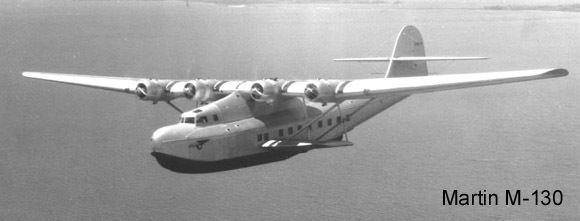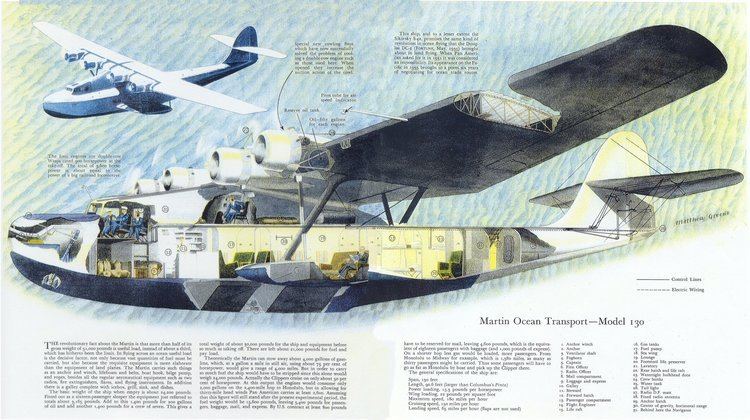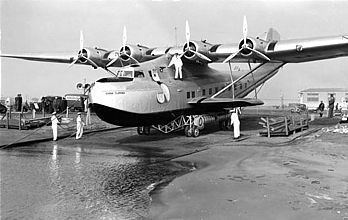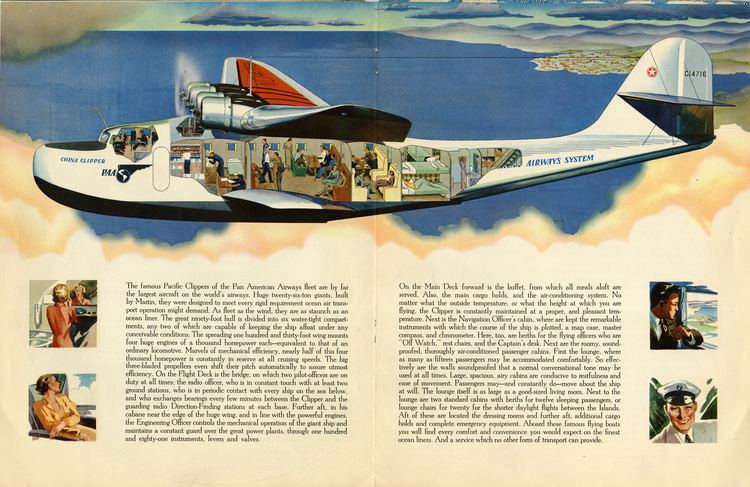Top speed 290 km/h Length 28 m | Wingspan 40 m Introduced October 1935 | |
 | ||
The Martin M-130 was a commercial flying boat designed and built in 1935 by the Glenn L. Martin Company in Baltimore, Maryland, for Pan American Airways. Three were built: the China Clipper, the Philippine Clipper and the Hawaii Clipper, all three had crashed by 1945. A similar flying boat, (the Martin 156), named Russian Clipper, built for the Soviet Union, had a larger wing (giving it greater range) and twin fins.
Contents
- The china clipper a huge new martin m 130 flying boat takes off from alameda hd stock footage
- Operational history
- Specifications Martin M 130
- References

Martin named them the Martin Ocean Transports, but to the public they were the "China Clippers", a name that became a generic term for Pan Am's large flying boats - the Martin M-130, Sikorsky S-42, and Boeing 314.

The china clipper a huge new martin m 130 flying boat takes off from alameda hd stock footage
Operational history

Designed to meet Pan American Airways President Juan Trippe's desire for a trans-Pacific aircraft, the M-130 was an all-metal flying boat with streamlined aerodynamics and powerful engines, selling at US$ 417,000, to achieve Pan Am's specified range and payload. The first flight was on December 30, 1934. On November 22, 1935, the China Clipper, piloted by Captain Edwin C. Musick and First Officer R.O.D. Sullivan flew the first trans-Pacific airmail route. As illustrated on this page, a postage stamp, Scott Catalog C-20, was printed for use on the transpacific service. With extended service two more denominations were later issued. All three have the same design showing the M-130 in flight.

Weekly passenger flights across the Pacific began in October 1936 when Hawaii Clipper left San Francisco for Manila, stopping overnight at Honolulu, Midway, Wake and Guam. An S-42 began flying the Manila-Hong Kong route in 1937 and the Martins replaced it in 1938.

In July 1938 Hawaii Clipper disappeared between Guam and Manila with the loss of nine crew and six passengers. No cause was determined.

Their range and capacity made them valuable for over ocean military flights during World War II. Beginning in 1942, the two remaining planes were pressed into transport roles for the United States Navy. The Philippine Clipper which survived the Japanese attack on Wake Island following the attack on Pearl Harbor crashed in January 1943 between Ukiah and Boonville, California on a flight from Honolulu. ComSubPac Admiral Robert H. English and 18 others were killed.
In January 1945 the last M-130, the China Clipper, left Miami on Pan Am's first scheduled flight to Leopoldville via Brazil. It broke up and sank during landing at Port of Spain, Trinidad and Tobago on January 8, killing 23 of those on board
Specifications (Martin M-130)
Data from
General characteristics
Performance
